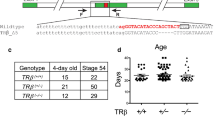Summary
We have investigated the effects of aXenopus alpha thyroid hormone receptor (TR) upon early development ofX. laevis. After deleting the 5′-untranslated region of a cloned TR cDNA, we synthesised TR transcripts that can be translated in oocytes and embryos. When embryos are supplied with this RNA by direct injection, functional TR can be detected through gastrula and neurula stage embryos, considerably in advance of the normal onset of TR expression in larval development. TR mRNA-injected embryos are precociously responsive to thyroid hormone (T3). In the absence of T3 such embryos develop completely normally, but addition of T3 to the medium bathing the embryos results in abnormal embryos with graded anterior (head) deficiencies, losing forehead, eyes and cement gland, progressively. The degree of abnormality is dependent upon the dose of T3 and the stage of development at which it is applied, embryos treated at stage 6 (32 cell) becoming more abnormal than those treated at stage 121/2 (late gastrula). Embryos injected with TR mRNA and treated with T3 are similar, but not identical, to embryos treated with retinoic acid in early development. As is the case with retinoic acid treatment, we show that the T3-dependent effects are due, at least in part, to effects on gastrulation movements.
Similar content being viewed by others
References
Brooks AJ, Sweeney G, Old RW (1989) Structure and functional expression of a clonedXenopus thyroid hormone receptor. Nucl Acids Res 22:9395–9405
Cooke J, Smith JC (1987) The midblastula cell cycle transition and the character of mesoderm in u.v.-induced nonaxialXenopus development. Development 99:197–210
Durston AJ, Timermans JPM, Hage WJ, Hendricks HFJ, de Vries NJ, Heideveld M, Nieukoop PD (1989) Retinoic acid causes an anteroposterior transformation in the developing central nervous system. Nature 340:140–144
Ellinger-Ziegelbauer H, Dreyer C (1991) A retinoic acid receptor expressed in the early development ofXenopus laevis. Genes Dev 5:94–104
Etkin W (1970) The endocrine mechanism of amphibian metamorphosis, an evolutionary achievement. Soc Endocrinol Mem 18:137–155
Gerhardt JC, Vincent J-P, Scharf SR, Black SD, Gimlich RL, Danilchick MV (1984) Localization and induction in early development ofXenopus. Phil Trans R Soc London (B) 307:319–330
Glass CK, Devary OV, Rosenfeld MG (1990) Multiple cell-type specific proteins differentially regulate target sequence recognition by the alpha retinoic acid receptor. Cell 63:729–738
Green S, Chambon P (1988) Nuclear receptors enhance our understanding of transcription regulation. Trends Genet 4:309–314
Inoue A, Yamakawa J, Yukioka M, Morisawa S (1983) Filter binding assay for thyroid hormone receptors. Analytical Biochem 134:176–183
Jones EA, Woodland HR (1986) Development of the ectoderm inXenopus: tissue specification and the role of cell association and division. Cell 44:345–355
Kawahara A, Baker BS, Tata JR (1991) Developmental and regional expression of thyroid hormone receptor genes duringXenopus metamorphosis. Development 112:933–943
Krieg PR, Melton D (1984) Functional messenger RNAs are produced by SP6 in vitro transcription of cloned cDNAs. Nucl Acids Res 12:7057–7070
Leloup J, Buscaglia M (1977) La triiodothyronine, hormone de la metamorphose des amphibiens. CR Acad Sci Paris, 24D, 2261–2263
Mathisen PM, Miller L (1989) Thyroid hormone induces constitutive keratin gene expression duringXenopus laevis development. Mol Cell Biol 9:1823–1831
Moskiatis JE, Sargent TD, Smith LH Jr, Pastori RL, Schoenberg DR (1989)Xenopus laevis serum albumin: sequence of complementary deoxyribonucleic acid encoding the 68- and 74-kilodalton peptides and the regulation of albumin gene expression by thyroid hormone during development. Mol Endocrinol 3:464–473
Naar AM, Boutin J-M, Lipkin SM, Yu VC, Holloway JM, Glass CK, Rosenfeld MG (1991) The orientation and spacing of core DNA-binding motifs dictate selective transcriptional responses to three nuclear receptors. Cell 65:1267–1279
Nakai A, Seino S, Sakurai A, Szilak I, Bell GI, Groot LJ (1988) Characterisation of a thyroid hormone receptor expressed in human kidney and other tissues. Proc Natl Acad Sci USA 85:2781–2785
Nieuwkoop PO, Faber J (1967) Normal Table ofXenopus laevis (Daudin), 2nd Edition, Amsterdam: North-Holland
Ruiz i Altaba A, Melton DA (1989) Involvement of theXenopus homeobox geneXhox3 in pattern formation along the anteriorposterior axis. Cell 57:317–326
Ruis I Altaba A, Jessel TM (1991a) Retinoic acid modifies the pattern of cell differentiation in the central nervous system of neurula stageXenopus embryos. Development 112:945–958
Ruiz i Altaba A, Jessel TM (1991b) Retinoic acid modifies mesodermal patterning in earlyXenopus embryos. Genes Dev 5:175–187
Sap J, Munoz A, Damm K, Goldberg Y, Ghysdael J, Lentz A, Beug H, Vennstrom B (1986) Thec-erb A protein is a high affinity receptor for thyroid hormone. Nature 324:635–640
Sive HL, Draper BW, Harland RM, Weintraub H (1990) Identification of a retinoic acid-sensitive period during primary axis formation inXenopus laevis. Genes Dev 4:932–942
Tata JR (1968) Early metamorphic competence ofXenopus larvae. Dev Biol 18:415–440
Thompson CC, Weinberger C, Lebo R, Evans RM (1987) Identification of a novel thyroid hormone receptor expressed in the mammalian nervous system. Science 237:1610–1614
Umesono K, Giguere V, Glass CK, Rosenfeld MG, Evans RM (1988) Retinoic acid and thyroid hormone induce gene expression through a common responsive element. Nature 336:262–265
Umesono K, Murakami KK, Thompson CC, Evans RM (1991) Direct repeats as selective response elements for the thyroid hormone, retinoic acid, and vitamin D3 receptors. Cell 65:1255–1266
Yoita Y, Brown DD (1990)Xenopus laevis alpha and beta thyroid hormone receptors. Proc Natl Acad Sci USA 87:7090–7094
Yoita Y, Shi Y-B, Brown DD (1990) A correlation of thyroid hormone receptor gene expression with amphibian metamorphosis. Genes Dev 4:1917–1924
Author information
Authors and Affiliations
Rights and permissions
About this article
Cite this article
Old, R., Jones, E.A., Sweeney, G. et al. Precocious synthesis of a thyroid hormone receptor inXenopus embryos causes hormone-dependent developmental abnormalities. Roux's Arch Dev Biol 201, 312–321 (1992). https://doi.org/10.1007/BF00592112
Received:
Accepted:
Issue Date:
DOI: https://doi.org/10.1007/BF00592112



